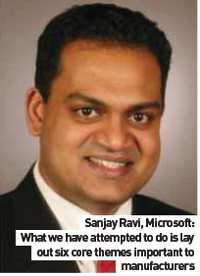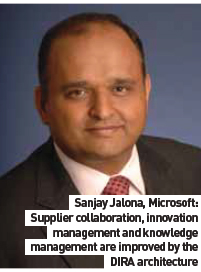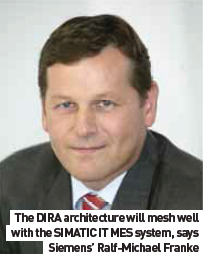Driven by the results of a detailed industry survey, Microsoft has launched a new architecture designed to improve manufacturing process control
A recent poll conducted by the company served to highlight the capability of new technology advances now available across the digital infrastructure, including such elements as cloud computing and social networking, with the goal of transforming manufacturing industry value chains.
Called the Microsoft Discrete Manufacturing Cloud Computing Survey 2011, the results of the questionnaire included responses from 152 IT and business decisionmakers within automotive and other grous around the world. According to 48.3% of respondents, the most benefit to be gained from cloud computing was lowering the cost of optimized infrastructure. This was closely followed by efficient collaboration across geographies (47.7%) and the ability to respond quickly to business demands (38.4%).
Sanjay Ravi, Managing Director, Worldwide Discrete Manufacturing Industry for Microsoft, spoke about how the company had interpreted the poll results: “The survey shows current cloud computing initiatives are targeted at cost reduction, but a growing number of forward-looking companies are exploring new and innovative business capabilities uniquely delivered through the cloud.
“Manufacturers are exploring ways to improve product design with social product development, enhance visibility across multiple tiers in the value chain and create new business models and customer experiences based on smart devices connecting to the cloud.”
The survey results revealed a need to better integrate collaboration tools with business systems (47.4%) and improved access to unstructured data and processes (36.2%). Almost 60% of respondents saw an industrywide collaboration including manufacturing products and services providers, IT providers, systems integrators and in-house business analysts as most capable of bringing about these improvements.
To aid collaboration across all stakeholders, the company has created a Reference Architecture Framework for Discrete Manufacturers Initiative (DIRA framework) to drive solutions based on cloud computing across manufacturing networks, which would help to integrate processes within and across an enterprise, extend the reach of the network to more companies globally, and connect smart devices to the cloud. Partners involved in the initiative currently include Apriso, Camstar Systems, ICONICS, Rockwell Automation, Siemens MES and Tata Consultancy Services.

 The DIRA framework is intended to manage complexity by ‘distilling’ various business challenges, industry trends, and technology trends into six business-enhancing themes – or pillars - that provide ways to analyze and develop solutions for enterprise business initiatives. We asked Sanjay Ravi if DIRA should be viewed as a ‘master’ software initiative? “To define DIRA, it is intended to help OEMs and suppliers address the key emerging business issues in manufacturing and gain maximum benefits from their technology investments by providing a framework with the critical capabilities required to drive competitive success.” “As an example, Siemens is looking to connect manufacturing processes with smart devices, [in order to] collect data and pass this info on to the cloud. What we have attempted to do is lay out six core themes important to manufacturers.”
The DIRA framework is intended to manage complexity by ‘distilling’ various business challenges, industry trends, and technology trends into six business-enhancing themes – or pillars - that provide ways to analyze and develop solutions for enterprise business initiatives. We asked Sanjay Ravi if DIRA should be viewed as a ‘master’ software initiative? “To define DIRA, it is intended to help OEMs and suppliers address the key emerging business issues in manufacturing and gain maximum benefits from their technology investments by providing a framework with the critical capabilities required to drive competitive success.” “As an example, Siemens is looking to connect manufacturing processes with smart devices, [in order to] collect data and pass this info on to the cloud. What we have attempted to do is lay out six core themes important to manufacturers.”
Development of the discrete manufacturing reference architecture will be an ongoing effort led by Microsoft, with close collaboration through participating companies, including industry solution vendors and systems integrators. The initiative outlines six key themes to guide this development: natural user interfaces; role-based productivity and insights; social business; dynamic value networks; smart connected devices; and security-enhanced, scalable and adaptive infrastructure.
DIRA framework and partnerships
Microsoft has developed the principles of the DIRA framework in conjunction with the technology adoption plans and solution strategies of its key partners. Several Microsoft partners across various areas of manufacturing have endorsed the DIRA framework because it helps them to deliver high levels of customer value through complementary solutions aligned with the framework.
AMS spoke with designers and users of the system, analysts and industry partners, in order to get an idea of how applicable this initiative could prove for automotive manufacturing. First, Sanjay Ravi, one of the main architects of the enterprise, about what the main drivers of this initiative: “Globalization has fragmented industry value chains, making them more complex and unable to quickly respond to increased competition and faster time to market. Cloud computing is empowering today’s global manufacturers to rethink how they innovate and collaborate across the value chain.
“As a result of these increasingly rapid changes in technology and business, manufacturers are seeking guidance on how to best plan and deploy these powerful technologies in concert with their business strategies and priorities and how to achieve greater competitive differentiation. Microsoft is leading a DIRA framework in response to this need while offering a pragmatic solution road map for IT integration and adoption.”
For an external opinion on the framework, AMS spoke to Julie Fraser, analyst at Boston-based Cambashi Inc.: “The DIRA framework appears to be a solid foundation for the next-generation of plant floor software for discrete manufacturers.” She continued: “Microsoft has been a leader in plant floor software system standards and interoperability initiatives over many years. Our bet is that Microsoft and their ecosystem of partners will succeed.”
The phrase ‘dynamic value network’ has been used a lot in this area of IT and control, as Fraser explained: “What we now call a dynamic value network is what would in the past have been called a responsive supply chain. The industry has come a long way in making its supply chains more dynamic, more responsive. I think one of the big things that the auto industry has done to help itself survive is to have a better supply chain communications with less adversarial attitude.” How have recent events influenced an analyst’s view on supply chain dynamics? “In the past, OEMs have pushed information requirements onto their suppliers - now the OEMs are taking more responsibility. ”
 But what of the factory floor environment? How will smart devices and other technology help there? Fraser is enthusiastic about this: “An auto plant floor is the perfect place to place a connected smart device for detecting and analysing conditions. They are perfect for detecting excess vibration in a process before there is a fault that affects production. Self-diagnostics are central to smart connected devices so they can ‘look after themselves’, as well as connecting to monitoring activities. “On a plant floor, using a smart device, we can more easily get a set of results of a process, perhaps from just one worker, and then show this to many parts of the manufacturing supply chain.”
But what of the factory floor environment? How will smart devices and other technology help there? Fraser is enthusiastic about this: “An auto plant floor is the perfect place to place a connected smart device for detecting and analysing conditions. They are perfect for detecting excess vibration in a process before there is a fault that affects production. Self-diagnostics are central to smart connected devices so they can ‘look after themselves’, as well as connecting to monitoring activities. “On a plant floor, using a smart device, we can more easily get a set of results of a process, perhaps from just one worker, and then show this to many parts of the manufacturing supply chain.”
So, what are the challenges? “I think the hardest parts are the social business aspect; there is a fundamental difference between systems of record, ERP, MES, EDI, etc., and systems of engagement, discussions, social media. The challenge will be how these observations are translated into action in the business world. The leastdeveloped today, out of the six pillars, is the social business aspect.”
We asked a selection of industry experts how the architecture will fit within existing softwares. “Siemens welcomes the new DIRA framework, which is a good fit to its own industry software offering and Totally Integrated Automation approach,” said Ralf-Michael Franke, CEO Industrial Automation Systems, Siemens. “We expect this architecture to leverage an improved interoperability information flow between the shopfloor and the enterprise functions, as well as increase efficiency between enterprise systems and enterprises throughout the supplier network. The Siemens MES product, SIMATIC IT, is just one example that aligns well with this reference architecture.”
“A comprehensive reference architecture is essential for dynamic, data-driven applications [in order] to meet current and future challenges,” said Scott Jones, Chief Technology Officer and Vice-President of R&D at Camstar Systems. “Customers will benefit from these technologies to assist in solving complex business problems and meeting today’s industry needs.”
 “At Tata Consultancy Services, we help the manufacturing industry improve competitiveness with best-of-breed solutions that deliver business functionality, integration and data synchronization. Our solution uses industry best practices for all manufacturing enterprise roles,” said Kalpan Raval, Practice Director for Enterprise Solutions at TCS. “The solution ensures full integration between shopfloor systems, Siemens MES, enterprise resource planning and other data sources, which enable lean and traditional scheduling principles to be readily applied. Using this newly-released reference architecture, we expect to accelerate value realization for our customers due to asset-leveraged, shorter implementation cycles.”
“At Tata Consultancy Services, we help the manufacturing industry improve competitiveness with best-of-breed solutions that deliver business functionality, integration and data synchronization. Our solution uses industry best practices for all manufacturing enterprise roles,” said Kalpan Raval, Practice Director for Enterprise Solutions at TCS. “The solution ensures full integration between shopfloor systems, Siemens MES, enterprise resource planning and other data sources, which enable lean and traditional scheduling principles to be readily applied. Using this newly-released reference architecture, we expect to accelerate value realization for our customers due to asset-leveraged, shorter implementation cycles.”
“The principles of discrete manufacturing reference architecture align well with key offerings from Infosys, such as Supply Chain Visibility and Collaboration product suite and manufacturing collaboration accelerators,” said Sanjay Jalona, Vice- President and Head of Manufacturing North America, Infosys Technologies Ltd. “These offerings take advantage of Microsoft technologies to solve business challenges like supplier collaboration, innovation and knowledge management.”
































